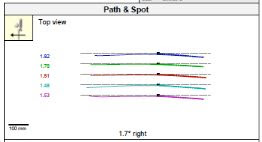Last month we talked about the best stroke pattern for a face balanced mallet. I think I surprised a number of you by recommending a putting stroke that exits left, rather than the traditional thought of straight back and then straight down the target line. In our system, the closest to the vertical plane that would match this perception is represented by Profile 2. For a 10 foot putt, we would see 2 degrees or less rotation in the backswing, on a very slight arc, parallel to the target line. With a mallet, this arc is basically imperceptible and hence the straight back and straight through description.
As we described last month, the down side of a true face balanced putter with a center of gravity deep in the head, is that the toe often lags behind the heel of the putter, causing the face to be open at impact if the putter is swung on a parallel plane to the target line. With a cog farther from the face the slow down is enhanced. While the effect is minimal, a little open is enough to create a push - miss tendency and you Burn the Edge.
There are probably dozens of ways a player could compensate for the push miss, but three come immediately to mind. Swing away from the miss, as we described previously. Aim away from the miss, is a common reaction for most players. We see it on the tour all the time. This fix requires a ton of practice and is a topic for another time as it is more a strategic fix than a putter fit issue.
The other common reaction is an over-active trail hand to over come the toe drag and square the face at impact. This is an issue we want to fix with putter fit. Given that every putt requires a different speed and length of stroke, trying to time impact of every putting stroke with your hands is a source of grief for countless golfers. Just look at the overwhelming number of grip shapes, grip weighting and hand positions. All in an effort to control impact position. As we continue to evaluate putting strokes and players, the most successful fits are when we find the appropriate shaft location and face balance to match the stroke and eliminate the steer.
While Profile 2 requires a very small rotation and slow rotational speed through the ball, it requires some rotation to maintain a consistent position relative to the path. We found our best success by using Scotty Cameron's concept of "almost" face balanced that you find in many of his models as the best solution. These models balance at approximately 15 degrees of toe hang, just enough to free up the feel of the putter in motion and allow the toe to keep up with the heel without any extra effort.
If you have a perception of straight back and straight through and fight a push, we would highly recommend a putter with the cog closer to the face and a slight amount of toe hang. It might be a simple solution to your problem.
Feel free to contact us at Burnt Edges Consulting for a list of putters featuring this design parameter.
As we described last month, the down side of a true face balanced putter with a center of gravity deep in the head, is that the toe often lags behind the heel of the putter, causing the face to be open at impact if the putter is swung on a parallel plane to the target line. With a cog farther from the face the slow down is enhanced. While the effect is minimal, a little open is enough to create a push - miss tendency and you Burn the Edge.
There are probably dozens of ways a player could compensate for the push miss, but three come immediately to mind. Swing away from the miss, as we described previously. Aim away from the miss, is a common reaction for most players. We see it on the tour all the time. This fix requires a ton of practice and is a topic for another time as it is more a strategic fix than a putter fit issue.
From left to right faster rotation to slower rotation through the ball.
With the same neck to face position, face balance will move toward horizontal from left to right.
|
The other common reaction is an over-active trail hand to over come the toe drag and square the face at impact. This is an issue we want to fix with putter fit. Given that every putt requires a different speed and length of stroke, trying to time impact of every putting stroke with your hands is a source of grief for countless golfers. Just look at the overwhelming number of grip shapes, grip weighting and hand positions. All in an effort to control impact position. As we continue to evaluate putting strokes and players, the most successful fits are when we find the appropriate shaft location and face balance to match the stroke and eliminate the steer.
 |
| Cameron Select Fastback 15 degrees of Toe Hang |
If you have a perception of straight back and straight through and fight a push, we would highly recommend a putter with the cog closer to the face and a slight amount of toe hang. It might be a simple solution to your problem.
Feel free to contact us at Burnt Edges Consulting for a list of putters featuring this design parameter.








































